urban ambiance UHP9282 Installation guide
- Category
- Household fans
- Type
- Installation guide
This manual is also suitable for

UHP9280, UHP9281, UHP9282

Date Pu rch ased
Store Purchased
Mod el No .
Serial No.
Vendor No.
Limited Lifetime Warranty
Progress Lighting fan motors are warranted to the original purchaser to be free of electrical and/or mechanical defects for so
long as the original purchaser owns the fan. Pull chain switches, reverse switches, capacitors and metal finishes are warranted to
be free from defects in materials or workmanship for a period of 1 year from the date of purchase. Warping of wooden or plastic
blades is not covered by this warranty nor is corrosion and/or deterioration of any finishes for fans installed within ten miles of
any sea coast. Extended warranties for ENERGY STAR® qualified products may apply.
Progress Lighting ceiling fans with built-in LED light sources, when properly installed and under normal conditions of use, are
warranted to be free from defects in material and workmanship which cause the light sources to fail to operate in accordance
with the specifications for (i) five (5) years from the date of purchase on the LED Light modules and electrical components for
fans used in single family residences, and (ii) three (3) years from the date of purchase on the LED Light modules and electrical
components for fans used in multi-family or commercial applications. LED bulbs supplied by Progress Lighting carry no
warranty other than manufacturer’s warranty. Non-LED bulbs carry no warranty.
With proof of purchase, the original purchaser may return the defective fan to the place of purchase during the first 30 days for
replacement. After 30 days, the original purchaser MUST contact Progress Lighting at (864) 678-1000 for repair or replacement
which shall be determined in Progress Lighting’s sole discretion and shall be purchaser’s sole and exclusive remedy.
Labor and Shipping Excluded. This warranty does not cover any costs or fees associated with the labor (including, but not
limited to, electrician’s fees) required to install, remove, or replace a fan or any fan parts.
This warranty shall not apply to any loss or damage resulting from (i) normal wear and tear or alteration, misuse, abuse or
neglect, or (ii) improper installation, operation, repair or maintenance by original purchaser or a third party, including without
limitation improper voltage supply or power surge, use of improper parts or accessories, unauthorized repair (made or
attempted) or failure to provide maintenance to the fan.
THE FOREGOING WARRANTIES STATE PROGRESS LIGHTING’S ENTIRE WARRANTY OBLIGATION AND
ORIGINAL PURCHASER’S SOLE AND EXCLUSIVE REMEDY RELATED TO SUCH PRODUCTS. PROGRESS
LIGHTING IS NOT RESPONSIBLE FOR DAMAGES (INCLUDING INDIRECT, SPECIAL, INCIDENTIAL OR
CONSEQUENTIAL), DUE TO PRODUCT FAILURE, WHETHER ARISING OUT OF BREACH OF WARRANTY,
BREACH OF CONTRACT, OR OTHERWISE. THIS WARRANTY IS GIVEN IN LIEU OF ALL OTHER WARRANTIES,
WHETHER EXPRESSED OR IMPLIED, INCLUDING THOSE OF MERCHANTABILITY, FITNESS FOR A PARTICULAR
PURPOSE OR NONINFRINGEMENT.
Some states do not allow limitations on how long an implied warranty lasts or the exclusion or limitations of incidental or
consequential damages, so the above limitations and exclusions may not apply to you. This warranty gives you specific rights
and you may have other rights which vary from state to state.
UPC

Table of Contents
Safety Rules.....................................................................................................................................................................................
Unpacking Your Fan .......................................................................................................................................................................
Installing Your Fan .........................................................................................................................................................................
Installing the Metal Cover ...............................................................................................................................................................
Operating Your Transmitter ............................................................................................................................................................
Care of Your Fan ............................................................................................................................................................................
Troubleshooting ............................................................................................................................................................................
Specifications ................................................................................................................................................................................
1.
2.
3.
7.
8.
9.
10.
11.

1. Safety Rules
1.To reduce the risk of electric shock, ensure electricity has been turned off
at the circuit breaker or fuse box before beginning.
2.All wiring must be in accordance with the National Electrical Code and
local electrical codes. Electrical installation should be performed by a
qualified licensed electrician.
3.WARNING:To reduce the risk of electricalshock and fire, do not use
this fan with any solid-state fan speed control device.
4. WARNING: To reduce the risk of fire, electric shock, or personal injury,
mount to outlet box marked "Acceptable for Fan Support of 15.9 kg (35 lbs.)
Or Less" and use mounting screws provided with the outlet box. Most outlet
boxes commonly used for the support of light fixtures are not acceptable for
fan support and may need to be replaced. Due to the complexity of the
installation of thisfan,aqualifiedlicensedelectrician is strongly
recommended.
WARNING
TO REDUCE THE RISK OF FIRE, ELECTRIC SHOCK OR PERSONAL
INJURY, MOUNT FAN TO OUTLET BOX MARKED ACCEPTABLE FOR
FAN SUPPORT.
5. The outlet box and support structure must be securely mounted and
capable of reliably supporting a minimum of 35 lbs (15.9 kg) or less.
Use only UL-listed outlet boxes marked FOR FAN SUPPORT.
6. The fan must be mounted with a minimum of 7 ft (2.1m) clearance from
the trailing edge of the blades to the floor.
7.To operate the reverse function on this fan, press the reversing button while
the fan is running.
8.Avoid placing objects in the path of the blades.
9.To avoid personal injury or damage to the fan and other items, be
cautious when working around or cleaning the fan.
10.Do not use water or detergents when cleaning the fan or fan blades. A
dry dust cloth or lightly dampened cloth will be suitable for most
cleaning.
11.After making electrical connections, spliced conductors should be
turned upward and pushed carefully up into the outlet box. The wires
shouldbespreadapartwiththegroundedconductorandthe
equipment-grounding conductor on one side of the outlet box.
12. Electrical diagrams are for reference only. Light kits that are not packed
with the fan must be UL Listed and marked suitable for use with the
modelfanyouareinstalling.SwitchesmustbeULGeneralUse
Switches. Refer to the Instructions packaged with the light kits
NOTE
READ AND SAVE ALL INSTRUCTIONS!
WARNING
TO REDUCE THE RISK OF PERSONAL INJURY, DO NOT BEND THE
BLADE ARMS (ALSO REFERRED TO AS BRACKETS) DURING
ASSEMBLY OR AFTER INSTALLATION. DO NOT INSERT OBJECTS IN
THE PATH OF THE BLADES.

Unpack your fan and check the contents. You should have the following items:
Unpacking Your Fan 2.
14. Loose parts bag containing:
a. Blade up screw (6+1)
b. Blade down screw (6+1)
c. Motor housing screw (6)
d. Washer (6+1)
e. Mounting hardware
Wire nuts (4)
1. Fan blades (3)
2. Hanger bracket
3. Ball/downrod assembly
4. Canopy
5. Decorative cover
6. Coupling cover
7. Motor housing
8. Fan motor assembly
9. Blade support plate
10. Metal cover
11. Transmitter incl. holder + 2 mounting screws
12. 3V battery
13. Receiver with 6 wire nuts
1
2 7
11
12
13
8
9
10
3
4
5
6
14
a b c
d e
56
12
0
3
4

Tools Required
Phillips screw driver, straight slot screw driver,
adjustable wrench, step ladder, and wire cutters.
Mounting Options
If there isn't an existing UL listed mounting box,
then read the following instructions. Disconnect
the power by removing fuses or turning off
circuit breakers.
Secure the outlet box directly to the building
structure. Useappropriate fasteners and building
materials. The outlet box and its support must be
able to fully support the moving weight of the
fan (at least 35 lbs). Do not use plastic outlet
boxes.
Figure 4
Figure 3
Figure 1
Figure 2
Outlet box
Outlet box Outlet box
Note: You may need a longer downrod to
maintain proper blade clearance when installing
on a steep, sloped ceiling.
To hang your fan where there is an existing
fixture but no ceiling joist, you may need an
installation hanger bar as shown in Figure 4
(available at your Progress Lighting Retailer).
3. Installing Your Fan
WARNING
TO REDUCE THE RISK OF FIRE, ELECTRIC
SHOCK, OR OTHER PERSONAL INJURY,
MOUNT FAN ONLY TO AN OUTLET BOX
MARKED ACCEPTABLE FOR FAN SUPPORT
AND USE THE MOUNTING SCREWS
PROVIDED WITH THE OUTLET BOX. OUTLET
BOXES COMMONLY USED FOR THE
SUPPORT OF LIGHTING FIXTURES MAY NOT
BE ACCEPTABLE FOR FAN SUPPORT AND
MAY NEED TO BE REPLACED. CONSULT A
QUALIFIED ELECTRICIAN IF IN DOUBT.
Angled ceiling
maximum
25 angle
Recessed
outlet box
Provide strong support
Ceiling
hanger
bracket

4.
Hanging the Fan Attaching the Fan Blades
120V Wries
UL Listed
electrical
box
Motor
housing
screw(c)
Motor housing
Ceiling hanger
bracket
Washers
Mounting screws
(supplied with
electrical box)
Figure 6
Figure 5
Figure 8
Figure 7
Step 1. Position the fan so that the motor collar is
pointing up as seen in figure 6b. Attach the blade
and washer (d) to the fan motor assembly using blade
up screw as shown in Figure 6b. Repeat this step for
the 2 remaining blades and washers. Tighten the
screws securely.
Step 2. Turn the fan over and position it so that the
motor collar is pointing down. Attach the blade
support plate to the blade assembly using the blade
down screws. (Figure 7)
Step 3. Flip the fan back over so that the motor collar
is pointing up. Attach the motor housing using the
motor housing screws as shown in Figure 8.
REMEMBER to turn off the power. Follow
the steps below to hang your fan properly:
Step 1. Pass the 120-volt supply wires
through the center hole in the ceiling
hanger bracket as shown in Fig. 5.
Step 2. Secure the hanger bracket to the
ceiling outlet box with the screws and
washers provided with your outlet box. Figure 6b
Blade up
screw(a)
Washer(d)
Blade
Blade
Motor assembly
Blade up screw(a)
Washer(d)
Blade down
screw(b)
Blade assembly
Blade support plate
Motor
collar

WARNING
FAILURE TO PROPERLY INSTALL
LOCK PIN AS NOTED IN STEP 6
COULD RESULT IN FAN LOOSENING AND
POSSIBLY FALLING.
Figure 11
Step 4. Remove the hanger pin, lock pin and set
screws from the top of the motor assembly.
(Fig.9)
Step 5. Route wires exiting from the top of the
fan motor through the coupling cover, decorative
cover, canopy and then through the downrod.
(Fig. 10)
Step 6. Align the holes at the bottom of the
downrod with the holes in the collar on top of the
motor housing (Fig. 10). Carefully insert the hanger
pin through the holes in the collar and downrod. Be
careful not to jam the pin against the wiring inside
the downrod. Insert the lock pin through the hole
near the end of the hanger pin until it snaps into its
locked position, and tighten set screws as shown in
Fig.10. Cut off excess fixture wires leaving
approximately 6 to 9 inches above top of hanger
ball/downrod assembly.
Step 7. Carefully lift the assembly and rest the
hanger ball of downrod assembly on the hanger
bracket attached to the outlet box. Be sure the
groove in the hanger ball is lined up with the tab on
the hanger bracket. (Fig.11)
5.
Ball/downrod assembly
Lock pin
Hanger pin
Hanger ball
Motor assembly
Hanger bracket
Set screw
Figure 9
Figure 10
Canopy
Canopy
6-9 in
Downrod
Coupling
Cover
Coulping
cover
Decorative
cover
Decorative
cover
Hanger pin
Coupling
cover
Motor assembly
NO
OK
Motor collar

Figure 12
Figure 13
WARNING: To avoid possible electrical shock, be
sure electricity is turned off at the main fuse box
before wiring.
WARNING: Fan must be installed at a maximum
distance of 20 feet from the transmitting unit for
proper signal transmission between the transmitting
unit and the fan’s receiving unit.
If you feel you do not have enough electrical wiring
knowledge or experience, have your fan installed by
a licensed electrician.
Step 1. Connect green wires from EMI filter and
related parts according to the wiring diagram as
shown in Figure 13, make sure EMI filter is
properly seated in outlet box.
Step 2. Place the EMI filter into the ceiling box
before installing the receiver into the bracket. Insert
the receiver into the mounting bracket with the flat
side of the receiver facing the ceiling. (Fig. 12)
Step 3. Motor to receiver electrical connections:
Connect the grey wire from the fan to the grey wire
from the receiver. Connect the red wire from the fan
to the red wire from the receiver. Connect the
yellow wire from the fan to the yellow wire from
the receiver. (Fig.13)
Step 4. Receiver to house supply wires electrical
connections: Connect the black (hot) wire from the
ceiling to the black wire marked "AC IN L" from
the receiver. Connect the white (neutral) wire from
the ceiling to the white wire marked "AC IN N"
from the receiver. (Fig.13)
Secure all wire connections with the plastic wire
nuts provided
EMI Filter
Hanger bracket
6.
Make the Electric
Connections
AC IN L(Black)
AC IN N(White)
Ground wire
Gray
Yellow
Red
Red
Gray
Ground wire
Ground wire
Yellow
Ground wire
Ground wire
EMI Filter

Figure 14
Figure 15
All blades are grouped by weight. Because natural
woods vary in density, the fan may wobble even
though the blades are weighed equally.
The following procedure should correct most fan
wobbling problems. Check after each step.
1. Check that all blade and blade arm screws are secure.
2. Most fan wobbling problems are
caused when blade levels are unequal.
Check this level by
selecting a point on the ceiling above the
tip of one of the blades. Measure this
distance as shown in Figure 16. Rotate the
fan until the next blade is positioned for
measurement. Repeat for each blade. The
distance deviation should be equal within
1/8".
3. Use the enclosed Blade Balancing Kit if
the blade wobble is still noticeable.
4. If the
blade wobble is still noticeable,
interchanging two adjacent (side by side)
blades can redistribute the weight and
possibly result in smoother operation.
Attach the metal cover and rotate clockwise until it
goes all the way up and is tighten (Figure 15).
Hanger
bracket
Screw
Canopy
Decorative
cover
Metal cover
7.
Finishing the Installation
Installing the Metal Cover
Step 1. Tuck connections neatly into ceiling outlet
box.
Step 2. Slide the canopy up to mounting bracket and
place the key hole on the canopy over the screw on
the mounting bracket, turn canopy until it locks in
place at the narrow section of the key holes. (Fig. 14)
Step 3. Align the circular hole on canopy with the
remaining hole on the mounting bracket, secure by
tightening the two set screws. Note: Adjust the
canopy screws as necessary until the canopy and
canopy cover are snug.
WARNING
Make sure the notch on the hanging bracket properly
sits in the groove in the hanger ball before attaching
the canopy to the bracket by turning the housing until
it drops into place.
Blade Balancing
Touching
ceiling
Figure 16
WARNING
TO REDUCE THE RISK OF PERSONAL
INJURY, DO NOT BEND THE BLADE
HOLDERS WHILE INSTALLING,
BALANCING THE BLADES, OR CLEANING
THE FAN. DO NOT INSERT FOREIGN
OBJECTS BETWEEN ROTATING FAN
BLADES.

Operating Your Transmitter 8.
Remote Control Button Definitions:
1. “0 , 1 , 2 , 3 , 4 , 5 , 6” buttons:
These seven buttons are used to set the fan
speed as follows:
0 = Turn the fan OFF
1 = Minimum speed
2 = Low speed
3 = Medium low speed
4 = Medium speed
5 = Medium high speed
6 = High speed
Installing the Remote Control
Holder and Battery
Attach the remote control holder with the
remote control holder mounting screw.
(Figure 18)
Install a 3V battery (included) into the remote
control. To prevent damage to the remote
control, remove the battery if not use for long
periods. (Figure 18)
Figure 17
Figure 18
Step 1
Step 7
Step 2 Step 3
Step 4
Step 5
Step 8
Step 6
x 2
2. “ ” button: Reverse switch (control the
direction)

Speed settings for warm or cool weather depend on
factors such as the room size, ceiling height, number
of fans and so on.
NOTE: To operate the reverse function on this fan,
press the reverse button on the remote while the fan is
running.
Warm weather - (Forward) A downward airflow
creates a cooling effect as shown in Fig. 19. This
allows you to set your air conditioner on a warmer
setting without affecting your comfort.
Cool weather - (Reverse) An upward airflow moves
warm air off the ceiling area as shown in Fig. 20. This
allows you to set your heating unit on a cooler setting
without affecting your comfort.
Figure 19
Figure 20
9. Care of Your Fan
Here are some suggestions to help you maintain your
fan
1. Because of the fan's natural movement, some
connections may become loose.
Check the support
connections, brackets, and blade attachments
twice a year.
Make sure they are secure.
(It is not
necessary to remove fan from ceiling.)
2. Clean your fan periodically to help maintain its new
appearance over the years. Use only a soft brush or
lint-free cloth to avoid scratching the finish. The
plating is sealed with a lacquer to minimize
discoloration or tarnishing. Do not use water when
cleaning. This could damage the motor, or the wood,
or possibly cause an electrical shock.
3.
There is no need to oil your fan.
The motor has
permanently lubricated bearings.
IMPORTANT
MAKE SURE THE POWER IS OFF AT THE
ELECTRICAL PANEL BOX BEFORE YOU
ATTEMPT ANY REPAIRS. REFER TO THE
SECTION "MAKING ELECTRICAL
CONNECTIONS"

Troubleshooting
10.
Solution
1. Check circuit fuses or breakers.
2. Check line wire connections to the fan and switch wire connections in the switch housing.
CAUTION: Make sure main power is off.
1. Make sure all motor housing screws are snug.
2. Make sure the screws that attach the fan blade bracket to the motor hub is tight.
3. Make sure wire nut connections are not rubbing against each other or the interior wall of the switch housing.
CAUTION: Make sure main power is off.
4. Allow a 24-hour "breaking-in" period. Most noise associated with a new fan disappear during this time.
5. Make sure the upper canopy is a short distance from the ceiling. It should not touch the ceiling.
1. Do not connect the fan with wall mounted variable speed control (s).
Problem
Fan will not start.
Fan sounds noisy.
Remote control
malfunction

11. Specifications
12.56
lbs
15.34
lbs
2.35'
Fan Size Speed Volts Amps Watts RPM CFM N.W. G.W. C.F.
60"
Low
High
120
120
These are approximate measures. They do not include Amps and Wattage used by the light kit.
This device complies with part 15 of the FCC Rules. Operation is subject to the following two conditions: (1) This device may not cause harmful interference,
and (2) this device must accept any interference received, including interference that may cause undesired operation.
Warning: Changes or modifications to this unit not expressly approved by the party responsible for compliance could void the user's authority to operate the
equipment.
NOTE: This equipment has been tested and found to comply with the limits for a Class B digital device, pursuant to Part 15 of the FCC Rules. These limits
are designed to provide reasonable protection against harmful interference in a residential installation. This equipment generates, uses and can radiate radio
frequency energy and, if not installed and used in accordance with the instructions, may cause harmful interference to radio communications.
However, there is no guarantee that interference will not occur in a particular installation. If this equipment does cause harmful interference to radio or
television reception, which can be determined by turning the equipment off and on, the user is encouraged to try to correct the interference by one or more of
the following measures:
- Reorient or relocate the receiving antenna.
- Increase the separation between the equipment and receiver.
- Connect the equipment into an outlet on a circuit different from
that to which the receiver is connected.
- Consult the dealer or an experienced radio/TV technician for help.
0.07
0.32
2.63
19.07
48
141
1912.03
6127.84
Questions?
Call our Customer Care Team at 1-855-303-4229
www.urbanambiance.com
-
 1
1
-
 2
2
-
 3
3
-
 4
4
-
 5
5
-
 6
6
-
 7
7
-
 8
8
-
 9
9
-
 10
10
-
 11
11
-
 12
12
-
 13
13
-
 14
14
urban ambiance UHP9282 Installation guide
- Category
- Household fans
- Type
- Installation guide
- This manual is also suitable for
Ask a question and I''ll find the answer in the document
Finding information in a document is now easier with AI
Related papers
-
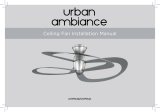 urban ambiance UHP9340 Installation guide
urban ambiance UHP9340 Installation guide
-
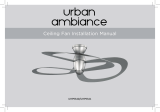 urban ambiance UHP9341 Installation guide
urban ambiance UHP9341 Installation guide
-
urban ambiance UHP9370 Installation guide
-
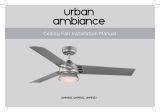 urban ambiance UHP9351 Installation guide
urban ambiance UHP9351 Installation guide
-
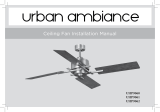 urban ambiance UHP9060 Installation guide
urban ambiance UHP9060 Installation guide
-
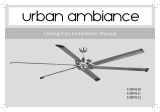 urban ambiance UHP9132 Installation guide
urban ambiance UHP9132 Installation guide
-
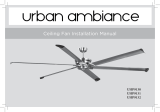 urban ambiance UHP9130 Installation guide
urban ambiance UHP9130 Installation guide
-
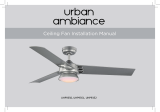 urban ambiance UHP9352 Installation guide
urban ambiance UHP9352 Installation guide
-
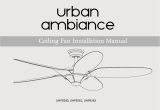 urban ambiance UHP9261 Installation guide
urban ambiance UHP9261 Installation guide
-
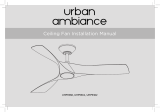 urban ambiance UHP9361 Installation guide
urban ambiance UHP9361 Installation guide
Other documents
-
Progress Lighting P2582-0930K Installation guide
-
Progress Lighting P2570-143 Installation guide
-
Progress Lighting P2550 Installation guide
-
Progress Lighting 93138704 C Installation guide
-
Progress Lighting P2596-12930K Installation guide
-
Progress Lighting P2564-2030K Installation guide
-
Progress Lighting P2568-1530K Operating instructions
-
Progress Lighting 93099661 B Installation guide
-
Progress Lighting P2574-8130K Installation guide
-
Progress Lighting P2548-0930K Installation guide






















